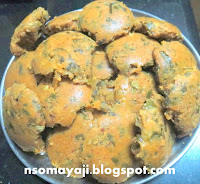Flax seeds -Coconut Chutney is a simple and easy dish. Chutney can be eaten with all most all main dishes like , idly dosa , chapati, roti, any masala rice or plain rice. Flax seeds contain a good lot of healthy minerals and vitamins and it is used in Indian Cooking. Even it is used in Cakes instead of eggs.
Lets see some benefits of eating Flax seeds.
Flax seeds are extremely good for one's health. They are a prime source of Omega -3 fatty acids and one should add flax seeds in their diet especially a vegetarian. They are rich in anti-oxidants and contain dietary fiber. Fiber prevents constipation and keeps you fuller for a longer time. Over weight people can eat flax seeds regularly. They also help people to keep diabetes, high BP, heart diseases away. They help to maintain blood sugar levels. Flax seeds are low in cholesterol. They help to lower the blood pressure, people who suffer from hypertension.
Here is a simple Flax seeds Coconut Chutney recipe, it tastes yemmy and as I said earlier we can have this chutney as one of the side dish and it goes well with all the main food items.
Green chilly : 3
Coconut : 1 Cup (1/2 of one coconut).
Salt : To taste
Ingh : a pinch
Tamarind : Small marble size
Coconut oil : 1 Tea spoon
Mustard seeds : 1/4 Tea spoon
Curry leaves : 5 to 6
Water : Required
2. Grate coconut and keep it aside.
3. Now grind coconut and roasted flax seeds with a small marble size of tamarind with very little water. Add salt and grind for 10 seconds when the chutney turn paste.
4. Remove from the mixi jar to a serving bowl.
5. Add mustard splutter and mix it well and serve with dosa, idly or the main dish you prepared.
We the family member had Flax seeds -Coconut chutney with Foxtail millet Dosa.
Foxtail dosa preparation is the same dosa procedure. Instead of rice I have used foxtail millet. The rest are the same urid dal, Methi seeds and beaten rice. (Awalakki).
Add little tamarind (Small marble size will do). Or you can use 1/2 lemon extract.
Adding mustard splutter is optional. Adding more or less coconut is also optional.
Time : 10 minutes
Serves : 3.
Lets see some benefits of eating Flax seeds.
Flax seeds are extremely good for one's health. They are a prime source of Omega -3 fatty acids and one should add flax seeds in their diet especially a vegetarian. They are rich in anti-oxidants and contain dietary fiber. Fiber prevents constipation and keeps you fuller for a longer time. Over weight people can eat flax seeds regularly. They also help people to keep diabetes, high BP, heart diseases away. They help to maintain blood sugar levels. Flax seeds are low in cholesterol. They help to lower the blood pressure, people who suffer from hypertension.
Here is a simple Flax seeds Coconut Chutney recipe, it tastes yemmy and as I said earlier we can have this chutney as one of the side dish and it goes well with all the main food items.
Things Needed :
Flax seeds : 2 Table spoons.Green chilly : 3
Coconut : 1 Cup (1/2 of one coconut).
Salt : To taste
Ingh : a pinch
Tamarind : Small marble size
Coconut oil : 1 Tea spoon
Mustard seeds : 1/4 Tea spoon
Curry leaves : 5 to 6
Water : Required
Method :
1. Fry or roast Flax seeds nicely and keep it aside. ( on low flame). Add green chilly and fry again for 1 minute. Add curry leaves.2. Grate coconut and keep it aside.
3. Now grind coconut and roasted flax seeds with a small marble size of tamarind with very little water. Add salt and grind for 10 seconds when the chutney turn paste.
4. Remove from the mixi jar to a serving bowl.
5. Add mustard splutter and mix it well and serve with dosa, idly or the main dish you prepared.
Foxtail dosa preparation is the same dosa procedure. Instead of rice I have used foxtail millet. The rest are the same urid dal, Methi seeds and beaten rice. (Awalakki).
Note :
Flax seeds must roast or fry nicely. Or you will get a raw smell from the chutney. (Do not over fry even).Add little tamarind (Small marble size will do). Or you can use 1/2 lemon extract.
Adding mustard splutter is optional. Adding more or less coconut is also optional.
Time : 10 minutes
Serves : 3.


















